Food and beverage businesses contend with a lot of pressure. Inflationary pressures from rent, electricity, ingredient and staffing costs in addition to foreign labour policy changes in Singapore all add to the challenge. Finding some levers you can pull to manage costs is all part of the balancing act.
Managing service costs and service quality is a lot like playing Jenga. How much can you remove while keeping the tower from collapsing? Reducing costs too much loses us customers while spending too much loses money. Rent and electricity cannot be quickly adjusted, but one of the pieces that has more room for manoeuvring is optimising staffing costs, also known as labour costs.
With that in mind, we’re going to explore what this type of Jenga piece staffing costs are, different ways you can analyse and monitor staffing costs and ultimately, different ways you can reduce staffing costs while maintaining high service quality.
What Makes Up Staffing Costs?
As restaurant owners, most of these costs are familiar to us but having a brief refresher will be good when we run through how we can analyse them later in this blogpost.
For the purposes of this article, we’ll split costs into 2 groups – monetary costs and non-monetary costs.
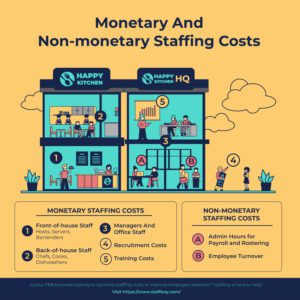
Monetary Staffing Costs
Monetary staffing costs are made up of salaries, wages and CPF for local Singaporean workers.
One thing to note when summing up your costs is that you should include not just the wait staff but everyone who draws wages and salaries in your business. This includes:
- Front-of-house staff: hosts, servers, bartenders
- Back-of-house or kitchen staff: chefs, cooks, dishwashers
- Managers and office staff
You’ll also want to take note of those who draw a salary as well as those who draw hourly wages. Regarding overtime, those who draw under SGD2600 are entitled to overtime pay as regulated under Singapore’s Employment act.
- Recruitment Costs
Recruitment costs track all the costs involved in hiring the worker: the recruitment team’s salary, their commissions or bonuses, costs of advertising or online job board postings, and the software you use to hire employees.
If you work with a hiring agency to help you manage this, their fees will be part of your recruitment costs.
- Training Costs
The costs of bringing new hires up to speed. Some would want to include the costs of the new hire’s equipment and uniform here as well.
Not all training costs are created equal. Depending on how training is structured, such as whether it is on-the-job or if there are structured group trainings, and whether the trainers are dedicated staff or are frontline staff training other frontline staff, your cost of training can vary widely.
A chef training another new chef may cost you more per man hour, not to mention the time tradeoff for training instead of cooking, compared to a cashier training an incoming cashier.
Training quality can also influence whether additional costs are incurred later on. While on-the-job training reduces the burden of training on the HQ team, the consistency of training may vary. Staff who are not fully trained may end up making costly mistakes down the road. These mistakes in turn affect employee morale and contribute to staff turnover. Costs like these are typically hard to account for, but can create very real consequences for F&B businesses.
As a fun fact: In 2017, accommodation and food services companies in Singapore spent the least on training. The highest spender on training was within the community, social and personal services industry.
Non-monetary staffing costs
Non-monetary costs are harder to pin a specific monetary value to but could cost your restaurant in other ways.
- Admin Time for Rostering and Payroll Processes
Rostering and payroll management takes admin hours from your management team and office staff. In one year, It can take north of 100 man hours to manage the payroll of 25 employees in the blue collar retail space because of changes and flexibility of shifts unlike white collar work.
Prior to software being available this process took hours and needed to be done regularly by restaurant managers, time that could be spent training and monitoring the team or making improvements to the service and food.
In addition, manual rostering and payroll is prone to human error. Overscheduling can incur unnecessary overhead and reduce staff productivity. Not scheduling enough staff can result in lost business, poor customer satisfaction and affect team morale.
Good software that can efficiently help you roster your staff can help shave off valuable hours off your management team.
- Employee Turnover
In 2022, Singapore’s food and beverage industry saw an employee turnover rate of 2.6 – that means 2.6 people resigned for every employee currently employed in this industry in 2022.
In the food and beverage industry, turnover is naturally high. Frequently, local hires could be doing this as a part time job or a summer contract job and leave after a while. Meanwhile, in Singapore, the allure of working on one’s feet for long hours and possibly on weekends is not a great one.
However, the non-monetary costs of employee turnover include lost productivity, training the replacement and staff morale costs.
Tracking and Monitoring Staffing Costs
Knowing where the staffing cost levers are depends on the context that you see the staffing cost in. First off, we’ll need to look at how labour costs factor into the overall equation.
Two powerful metrics to help make sense of this are:
- Sales per labour hour
- Labour cost percentage
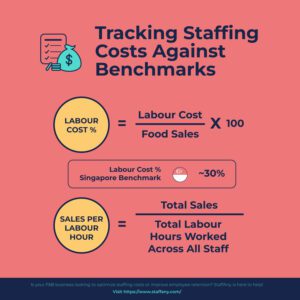
Sales per labour hour is calculated by adding the total sales revenue made divided by the total labour hours worked by all employees. This can be calculated across all outlets and at an outlet level. Outlets performing below the average indicate a potential issue with either revenue, where the outlet may not be making enough sales, or productivity, where there may be too many staff deployed.
The labour cost percentage is the sum of all monetary payments related to employees in your income statement as a percentage of your total sales for a period of time. You can then slice and dice these up to give you more context and control over your labour costs. We’ll dive deeper into how to utilise labour cost percentage for cost optimization.
You can then spot seasonal changes and isolate where and when the majority of your costs lie by calculating the labour cost percentage based across different time periods and staffing cost types. This keeps you from making decisions based on only one number.
For instance, let’s consider the scenario where your target is to keep staffing costs at 30% of sales, but in January, these costs escalated to 45%. While the jump is an issue, it’s essential to conduct a deeper analysis to uncover the reasons behind this increase.
You won’t know if your kitchen or front-of-house teams were overstaffed just by looking only at the full labour cost percentage. Context such as unexpected slow days or special events like business gatherings or birthday parties that need more staff are unaccounted for.
By looking at the numbers on a daily or even shift basis and finding out how much you spent on front-of-house, back-of-house staff, you can drill down to where costs could have overrun.
With that said, here are some ways to slice and dice your labour cost percentage:
Time periods
Just as peak hours and seasons change during the day and year, your labour cost percentage will fluctuate accordingly. Via historical analysis, you can track seasonality by calculating and monitoring your labour cost percentage over shifts, days, months, and years. You can then compare this year’s period compared to the same time last year to see if any trends exist.
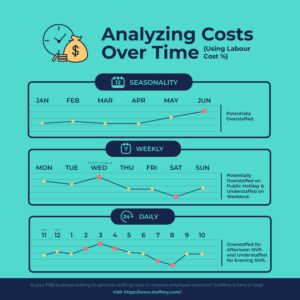
When doing this, you may notice that certain peak periods have more sales while some have less. Managers who manage on the front-line can notice these, but tracking the labour cost percentage across shifts gives you greater accuracy over how many staff you’ll need to roster for the morning and night shifts.
Tracking across the months and years will also give you greater context over whether that jump in staffing costs is a normal seasonal occurrence or an indicator that you may need to increase or decrease staff.
Staffing Types
You can further dive into your labour cost percentage by seeing how much each of these groups contribute to your total costs:
- Front-of-house staff
- Back-of-house staff
- Managers
Comparing the costs of these different groups across time in your restaurant can help show you if you are underspending or overspending in different areas. In certain cases, periods of high sales with abnormally low front and back of house staff costs could even indicate when you should add more staff to periods like this next time and vice versa.
Payment Types – Salary vs Hourly Wage
These split your costs between salaried workers and wage workers. Salaried staff costs can only be controlled by the number of staff you have while wage costs can be managed by the number of man hours they have worked. If you need temporary staff, it helps to split that as well considering that temp staff cost more per man hour compared to in-house wage staff.
What is critical is to ensure that a sufficient number of salaried staff that form the core of your team are deployed throughout the year while temporary staff are deployed as needed. A stable core of full time staff help ensure consistent performance and team culture, leading to more predictable revenue and costs.
Ways to Lower Your Staffing Costs
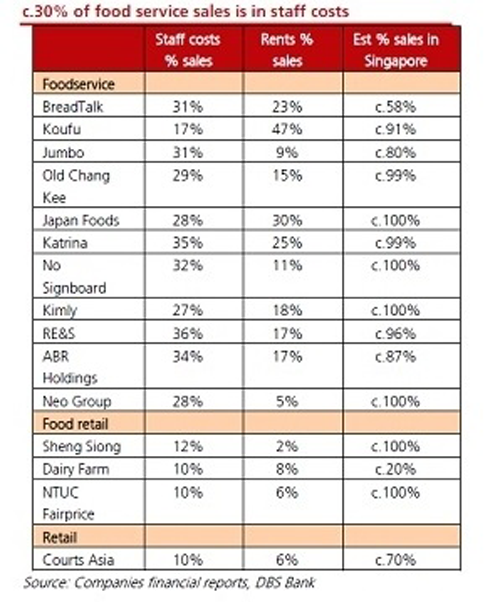
During the pre-pandemic days of 2019, the labour cost percentage of some of Singapore’s biggest names in food and beverage stood at 30%, which matches a common rule of thumb globally. While there isn’t a hard and fast rule that staffing costs need to be 30% or lower, it’s a good benchmark to have.
Depending on your type of business your target could be higher or lower, with full service restaurants spending more on specialised and highly trained staff and those without spending less.
From the above, there are a few levers that we can pull to lower costs. Staffing costs are mostly a factor of how many men you have on hand, how many you need to train and recruit, how much overtime they are due and how productive each man hour is. Each of the methods we have will help us optimise one or the other.
Optimising Manpower Requirements
Manpower Requirement – Predictive Analysis and Splitting Shifts
Finding out the sales per labour hour and labour cost percentages across the year, months, days and shifts will highlight periods of high and low sales. This historical analysis lets us predict how much manpower you’ll need to roster in the upcoming days and reduces the need for hiring temporary staff.
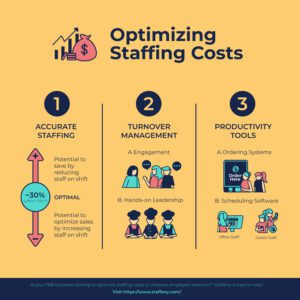
When labour cost percentage goes above the benchmark you’ve set for your restaurant, it indicates potential areas for savings as you may have deployed too many staff to the outlet. Conversely, a labour cost percentage below benchmark, assuming all other factors are consistent, may indicate there are too few staff on shift. This may mean you’re losing out on sales.
Restaurants who split shifts have more control over how many staff they have on hand during the day. For instance, in nightlife areas such as Clark Quay, night shifts will need more manpower compared to day shifts. F&B establishments in the central business district may need more staff in the morning and afternoons instead, while those in residential areas would need more staff on hand in the afternoon and evenings.
Having the right amount of manpower on hand during each shift can also help to keep overtime payments to a minimum or reduce the number of manhours required from your hourly wage workers.
Turnover
The food and beverage industry can be gruelling. Long hours, physical work and dealing with demanding customers are only some of the challenges that job seekers have to deal with when considering if they want to work in this industry. Hiring new workers has your restaurant bear more costs in terms of recruitment, equipment and training.
With the higher restrictions on foreign labour in Singapore, staff in the food and beverage industry are hard to come by so retaining anyone available will go a long way in managing your costs.
In this climate keeping employees around is challenging in almost every industry but more so in food and beverage. Common recommendations on the internet such as ‘team building exercises’ may not make sense for a restaurant that runs on shifts and needs to be open 7 days a week.
Engagement and leadership as turnover management
Having said that, employee engagement is still needed to keep a healthy pulse on worker morale. Two way communication between management and frontline teams allows for regular flow of information between stakeholders, keeping everyone updated on critical developments while allowing feedback from the ground to be heard by leaders.
Leaders in the F&B space may do this via various channels such as corporate events, company communication channels or tools that allow the collection and dissemination of information in an appropriate manner, such as by enabling anonymous feedback.
It also helps to show your employees that they are valued and appreciated. Ideally, those who show exemplary service should be rewarded and given opportunities to grow in the business. Communicating appreciation may seem like a simple thing to do, but in a gruelling and often thankless industry, even simple messages can go a long way.
Workforce engagement software can also be leveraged to keep employees motivated. For example, a tool like EngageAny helps restaurant staff remain punctual and excited to hit performance targets by providing incentives for good performance. Staff that are able to see how well they are performing on a daily basis are more likely to stay engaged and perform better.
Finally, having your restaurant manager or supervisor be hands-on is a surefire way to maintain morale as it helps keep employee stress levels manageable and to solve any issues outside the scope of the staff.
Productivity and Efficiency
Productivity – Ordering Software
Investing in ordering software can boost productivity by reducing the time your team spends on taking orders. This requires some discretion however. In many cases, taking the customer’s order is part of the dining experience and needing to view the menu via QR code can be a turn off for some diners.
Alternatives to the QR code menu software include ordering kiosks, such as the ones seen at fast food restaurants and also tableside tablet ordering solutions. If you haven’t implemented these yet, it’s good to consider the efficiency trade offs impact on the dining experience first as well.
Administration Man hours – Rostering Software
Rostering, timesheet management and managing manpower in general takes admin man hours from your restaurant managers. These hours can be saved by giving them the right software they can use anytime and anywhere to manage their manpower.
Thankfully, shift management software has come a long way. Tools like StaffAny help you hire, schedule, track and report your labour cost efficiency. Say goodbye to clumsy excel sheets and lost messages in a sea of instant messaging texts.
Psst: You can also find out how much money you can save using StaffAny with their calculator.
“It has since transformed and improved the way we work”
Casey, HR Manager
Morganfield’s
Accurate shift start and end times – Time attendance software
Time theft is another culprit that contributes to excessive but avoidable labor costs. When staff start their shifts early or end shifts beyond the time they were supposed to clock out, even if it is by an hour each time, labor costs can increase dramatically when considering all staff across all outlets over the span of a year.
Having a clock in clock out tool that accurately captures when staff reach the outlet and begins and ends their shift helps to track hours worked accurately, reducing time theft while maintaining fair compensation for staff.
The Wrap Up
At the end of the day, the way to manage staffing costs boils down to the nature of your restaurant business, the types of staff you need, how many you need to hire, how you deploy them and how frequently you need to replace them.
Taking the time to slice and dice your staffing cost percentage can give you clues as to where you can add or reduce the number of workers you need to optimise costs. Valuing your workers can go a long way to reduce staff churn.
Finally, you can also free up your managers’ time by giving them the right software to help with hiring, scheduling, tracking and reporting such as StaffAny. StaffAny is also trusted by names such as Ippudo, Ya Kun Kaya Toast and Morganfields. Try it for free today.












